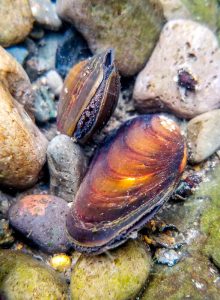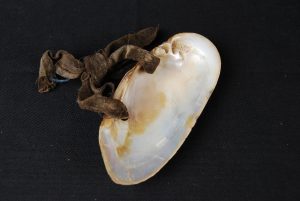
This is a story related by the freshwater mussel, or pipa, and describes how the pipa came to be used as a tool in harvesting millet, a job done by women. As Strong points out, the story highlights the feeling of responsibility the Ainu have for the stewardship of the land, the water, and the resources found there. The story also emphasizes the idea that good deeds and proper care of those resources lead to rewards, while lack of empathy or care for other living beings leads to negative outcomes.[1]
This story is at the upper beginner to intermediate level.

聞きましょう。
もう少しゆっくりで聞いてみましょう。
Here is the story in the Ainu language as transcribed by Chiri Yukie in the Ainu Shin’yōshū. [2] Punctuation is as per the original.
Pipa yaieyukar “Tonupeka ranran”
Tonupeka ranran
Satshikush an wa ottaokayashi ka
sat wa okere, tane anakne raiash kushki
“Nenkatausa wakka unkure
untemka okai! Wakkapo!” ohai chiraikotenke
okayash awa, too hosashi shine menoko
saranip se kane arki kor okai.
Chishash kor okayash awa unsama kush
unnukar awa,
“Toi pipa wen pipa, neptap chishkar hawe
iramshitnere okaipe neya?” itak kane
unotetterke unureetursere unseikoyaku,
toop ekimun paye wa isam.
“Ayapo, oyoyo! Wakkapo ohai!” chiraikotenke,
okayash awa too hosashi shui shine menoko
saranip se kane arki kor okai.
“Nenkatausa wakka unkure untemka okai!
Ayapo, oyoyo! Wakkapo!” ohai chiraikotenke,
okayash awa pon menoko kamui shirine
unsamta arki unnukat chiki,
“Inunukashki, shirsesek wa pipautar
sotkihi ka satwa okere, wakkaewen hawe
neshun okaine, nekonanep okai ruwe tan,
aotetterke apkor okai.” itak kane
unopitta unumomare, korham oro
unomare, pirka to oro unomare.
Pirka namwakka chieyaitemka
shino tumashnuash. Otta eashir
nea menokutar shinrichichi chihunara
inkarash awa, hoshkino ek unureeyaku
shirun menoko wen menoko anak Samayunkur
kottureshi newa, unerampokiwen
unshiknure pon menoko kamui moiremat anak
Okikirmui kottureshi ne awan.
Samayunkur kottureshi chiepokpa kushu
kor amamtoi chishumka wa, Okikirmui
kottureshi kor amamtoi chipirkare.
Ne paha ta Okikirmui kottureshi shino harukar.
chirenkaine ene shirkii eraman wa,
pipakap ari amampush tuye.
Orowano keshpaanko ainu menokutar
Amampush tuye ko pipakap eiwanke ruwe ne.
ari shine pipa yaieyukar.
Media Attributions
Reaping implement by the Trustees of the British Museum is licensed under CC BY-NC-SA 4.0.
“Freshwater mussels in the Molalla River” by BLM Oregon & Washington is licensed under CC BY 2.0.
